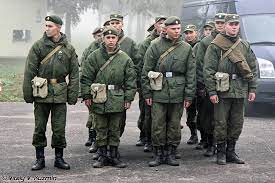Putin's announced mobilization of 300,000 "reservists" was jaw-dropping to me this morning, but not for the reason some might suspect.
Why? Because know how Russian soldiers are trained, in basic training & in their units.
A brief 🧵 on some fun facts. 1/
Why? Because know how Russian soldiers are trained, in basic training & in their units.
A brief 🧵 on some fun facts. 1/
While I commanded US Army Europe before retiring, before that I commanded all basic & advanced soldier training for the Army (2009-11).
During that period,≈150,000 new soldiers/year at (then) 5 basic training sites & 21 advanced training locations, received training.2/
During that period,≈150,000 new soldiers/year at (then) 5 basic training sites & 21 advanced training locations, received training.2/

Most new US soldiers get 10 weeks of basic training (some get more at one-station unit training (OSUT) sites, like infantry, artillery, MPs). Those that don't go to OSUT travel off to different length courses for advanced training in a "specialty" (logistics, intel, etc). 3/ 

It's a long period of time, trained by very professional drill sergeants. There is an extremely high resource overhead to all this.
Soldiers report to their units ready to be integrated in the specific mission.
Remember, the US population is 344 million & we train≈150k. 4/
Soldiers report to their units ready to be integrated in the specific mission.
Remember, the US population is 344 million & we train≈150k. 4/

Russia, on the other hand, has a population of 144 million citizens, spread over 11 time zones.
Theirs is a conscript force w/ 1 basic training site, (Labinsk in S. Russia). Some RU get advanced specialty training, but most RU soldiers get most training in their 1st unit. 5/
Theirs is a conscript force w/ 1 basic training site, (Labinsk in S. Russia). Some RU get advanced specialty training, but most RU soldiers get most training in their 1st unit. 5/

Russian soldiers got just a few days of basic training before being sent to Belarus starting last November (pre-invasion). themoscowtimes.com/2022/07/20/rus… 6/
During 2 visits to RU, I saw basic & unit training. It was awful. Familiarization versus qualification on rifles, rudimentary first aid, very few simulations to conserve resources, and...most importantly...horrible leadership by "drill sergeants." 7/
themoscowtimes.com/2020/02/17/dec…
themoscowtimes.com/2020/02/17/dec…
Officers admitted to me that theirs was a "one year" force, with some - the poorest - volunteering or being elected for leadership roles. 8/ 

Remember, RU soldiers get almost ALL training in units vs at basic.
How units are resourced play a big part.
One tank unit i visited near Moscow proudly told me they get 1 tank round/crew each year (US units spend hours in simulators & crews fire dozens of real rounds/year). 9/
How units are resourced play a big part.
One tank unit i visited near Moscow proudly told me they get 1 tank round/crew each year (US units spend hours in simulators & crews fire dozens of real rounds/year). 9/

BTW, Ukraine's army has taken the US model to heart after receiving training from US personnel in both individual and unit training techniques since 2014.
The establishment of JMTG-U by US Army, Europe was instrumental in that. Heres a link to that. 10/
eucom.mil/topic/jmtg-u
The establishment of JMTG-U by US Army, Europe was instrumental in that. Heres a link to that. 10/
eucom.mil/topic/jmtg-u
But I digress...
The issue is the Russian army is poorly led & poorly trained. That starts in basic training, and doesn't get better during the RU soldier's time in uniform.
Mobilizing 300k "reservists" (after failing with depleted conventional forces, rag-tag militias...11/
The issue is the Russian army is poorly led & poorly trained. That starts in basic training, and doesn't get better during the RU soldier's time in uniform.
Mobilizing 300k "reservists" (after failing with depleted conventional forces, rag-tag militias...11/
...recruiting prisoners & using paramilitaries like the Wagner group) will be extremely difficult.
And placing "newbies" on a front line that has been mauled, has low morale & who don't want to be portends more RU disaster.
Jaw-dropping. A new sign of RU weakness 12/12
And placing "newbies" on a front line that has been mauled, has low morale & who don't want to be portends more RU disaster.
Jaw-dropping. A new sign of RU weakness 12/12
• • •
Missing some Tweet in this thread? You can try to
force a refresh















